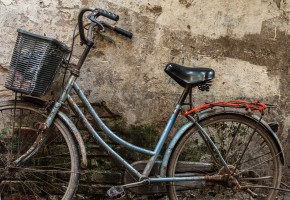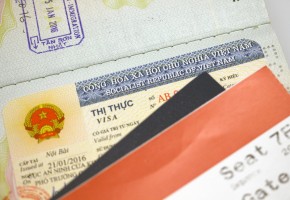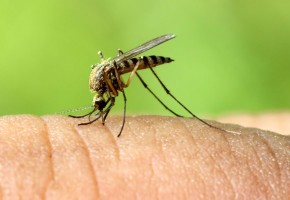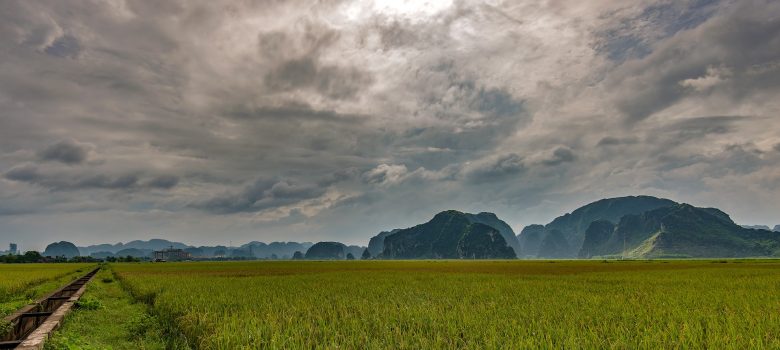
When to go: weather, seasons & festivals
Making sense of weather, seasons and when to go
When is the best time to visit Vietnam? And does it matter?
If you want to explore Vietnam beyond the major towns and southern beach resorts, to the mountains and valleys and lowlands and villages and spectacular coastlines that are the heart of the country, then yes, taking weather into account in your planning matters a lot.
It can make a huge difference to your trip.
However reliable information at the level of detail you need for effective planning can be hard to come by.
The usual temperature and rainfall charts won’t tell you, for example, that although it’s cool & dry in the middle of the Northern winter it can also be so grey and foggy that views may be poor and travel in the higher mountains impractical.
Or when, for example, are the best months to visit Ha Long and Lan Ha Bays — to have good views instead of fog, to avoid typhoons and the worst of the heat, but yet still be warm enough to swim. Or when to see the mountain or lowland rice terraces brilliant green, or golden yellow before harvest.
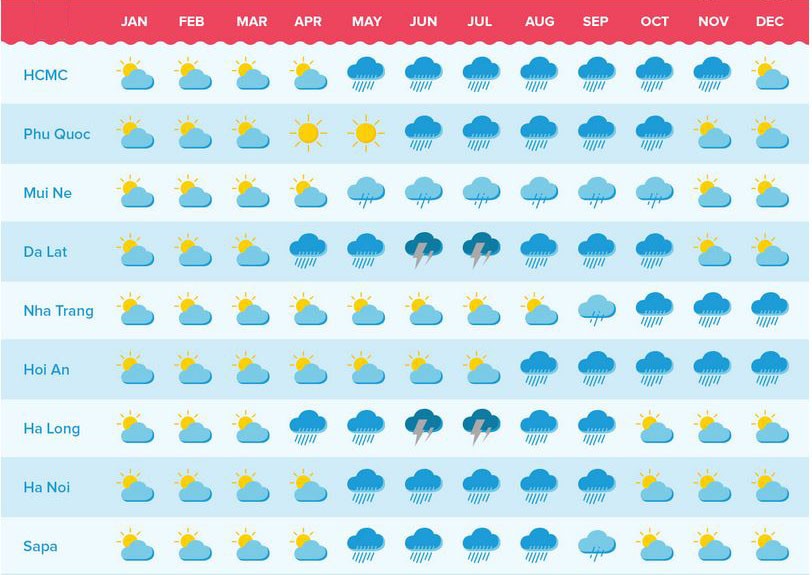
Our aim here is to gather together practical weather and seasons information to help you plan your trip. If your dates are fixed and you are working out where to go, then it will help in choosing which places to visit and what you can expect weatherwise. If you know pretty much where you want to go and are working out your dates, then it will help in deciding when to visit.
We also cover some key festivals — these are wonderful events in Vietnam, and worth including in your itinerary if you can.
Overall weather and seasons
Overall, Vietnam has a tropical monsoon climate, driven by the relatively warm and wet southeast monsoon between April and September, and the relatively cool and dry northeast monsoon from October to late March / early April.
However, with more than 3000 kilometers between the northern and southern tips, the monsoons affect different parts of the country differently, and it’s best to think of the country as having three distinct climate zones — the South, the North and the Center.
Being closer to the equator, the South has a tropical climate year-round, with just two seasons — wet (April to September) and dry (October to March).
In contrast, the North has a four-season climate with hot summers (May to August); relatively cool winters (November to March, with a cold December and January); and a short spring and autumn in between.
The Center is a somewhat unpredictable mix of the two, together with its own characteristics.
Arguably the best times overall to travel are during the spring season (around March – April, before the rains in the South and after the cold, often foggy mid-winter in the North) and the autumn season (around late September – October / early November, after the worst rains and heat of summer in the South and before the dry but cold, often foggy mid-winter in the North).
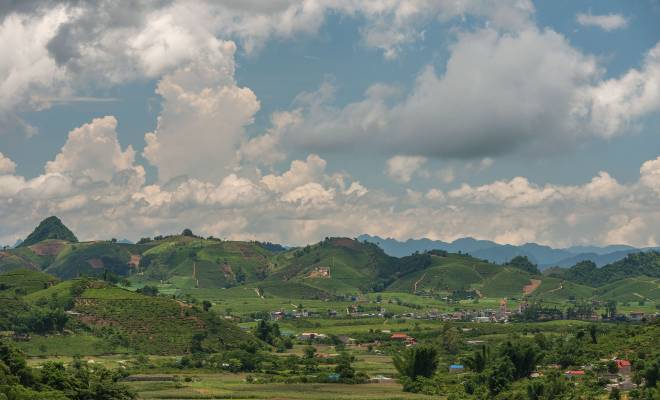
However, traveling in both summer and winter can be truly excellent, provided you plan your itinerary appropriately.
During the hot, wet season, and especially in the North, there are many mostly sunny days with the rain concentrated in intense thunderstorms that last just for a few hours. There are fewer tourists and often great views with the air washed crystal clear.
In winter, the beaches and islands of the South are often wonderful, and in the North there can be crisp, clear days and cold nights, mixed with days of clouds swirling dramatically around the mountains.
Layered on top of the monsoons, Vietnam gets about 4 – 6 typhoons plus a few strong tropical depressions a year, affecting mainly the central coast, but sometimes also the south and to a lesser degree the north. Storm season for the central coast is mostly August – September / October, but storms can also occur outside these times.
A large storm can bring heavy rains far to the south and north of the eye of the storm, covering a large part of Vietnam, and travel during these times can be difficult. Boat trips in Ha Long Bay can be cancelled, for example.
Big storms are hard to predict — probably the best approach is simply to add some contingency days to your schedule.

Fortunately, as mentioned above, August and September / October can be great times to travel outside the central coast — fewer crowds and many sunny days.
Late September / early October is generally when the rice harvest in the Northern mountains & highlands takes place. The terraced rice fields turn golden, and villages are very active cutting and threshing — it’s a fantastic time to travel.
Vietnam has wonderful national and regional festivals which tend to reflect the cycle of harvest seasons or historical ethnic or regional events — they are generally based on the lunar calendar and take place throughout the year.
Festivals in Vietnam are special, wonderfully colorful windows into national and ethnic culture, and worth planning to see.
Weather, season and calendar can thus have a big impact on when you might go, what you might see and do, and how much you enjoy your trip.
The good news is that with so much diversity of climate and region — from tropical beaches in the south to cool mountains in the north, from bustling cities to serene rice-terraced valleys and ethnic villages — Vietnam has something for travelers of all interests at (nearly) all times of the year, provided you do a little planning beforehand.
Weather & seasons in North Vietnam – detail
Northern Vietnam, stretching from Thanh Hoa in the south up to the Chinese border in the north and including Hanoi, Sapa and Ha Giang, has a cool to cold and mostly dry season from November to March, and a warm to hot wet season from April to September or October.
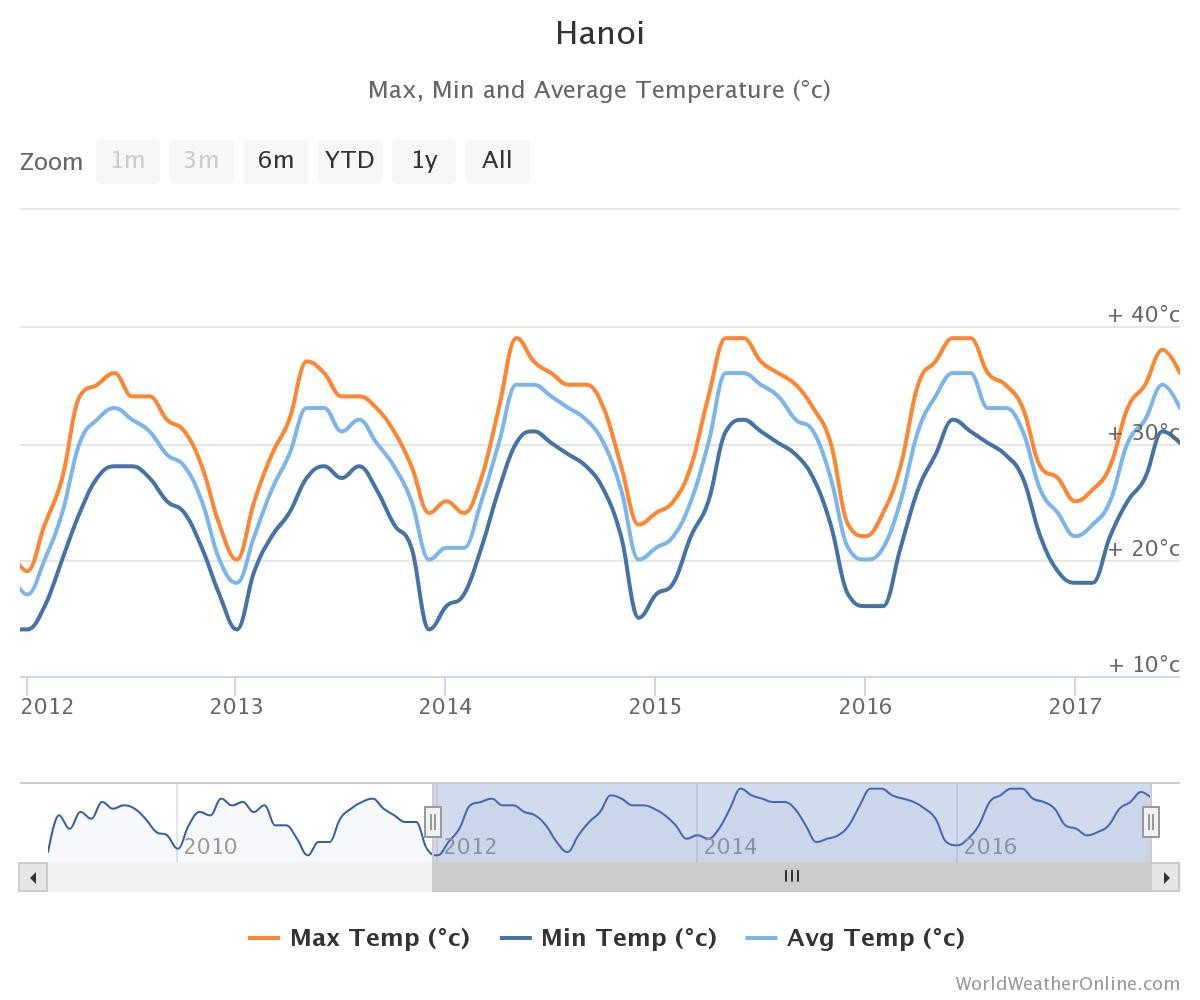
In Hanoi, from mid November to early March, the cooler weather often brings overcast skies, and especially in January & February the city can be grey and sometimes misty.
In the countryside and mountains, winter skies are also often cloudy and especially at higher elevations there can be low cloud and fog and limited visibility, but there is sun as well and by the end of January the proportion of cloud is beginning to fall.

Travel in the mountains at this time can be dramatic, with peaks often wreathed in swirling cloud, appearing and disappearing. When the clouds clear, the views are breathtaking. But an un-rushed itinerary and patience are required.
In October / November, buckwheat is planted on some of the mountain rice terraces and for a few weeks the hills are carpeted with flowers. On the lowlands, fields are often still green with winter crops or orchards, but at higher levels, once the buckwheat has finished, the rice terraces are mostly fallow awaiting the new planting next spring.
Winter can be a good time to explore and trek in lowland national parks and other areas where the forests are green all year round: Ba Be Lake, Cuc Phuong, Pu Luong, Xuan Son.

Travel, especially by motorbike, can be chilly — sometimes you may even see snow on the higher mountains — so it is important to be suitably prepared with warm clothing and waterproofs.

Down on the coast, in the Haiphong region, late September – November, after the monsoon storms and before the December peak season, is a good time to see Ha Long Bay with its astonishing karst limestone cliffs rising sheer from the water. The skies are mostly blue and the seas smooth, perfect for kayaking, and although by late November it’s probably getting a little cold for the beach and swimming, the lower tourist numbers make up for it.
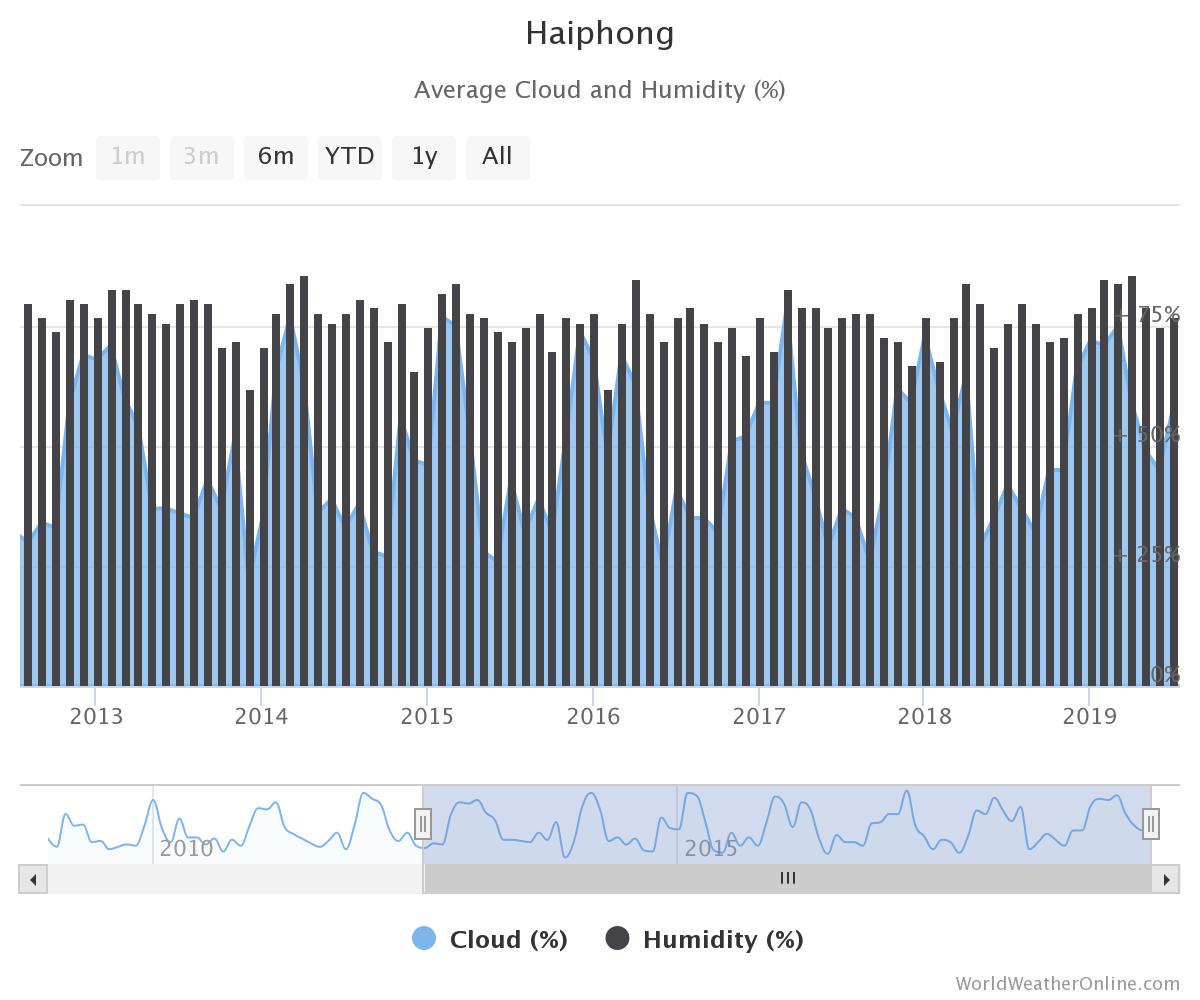
In the mountains, by the end of February / early March the clouds and fogs of winter are mostly gone and days are often relatively sunny.
Temperatures are still relatively mild and there is little rain. Although the fields are fallow and the new rice won’t be planted until April / May, the views are still splendid and it’s a good time to go trekking through fields, forests and villages, as well as trekking up the taller peaks, most of which are wonderfully remote and rarely visited or climbed.
At the end of the dry season, just after the first rains and a few weeks before the new planting, the rice terraces are often filled with water and the staircases of flooded terraces falling down the mountainsides and reflecting the sky are one of the great sites of Vietnam.
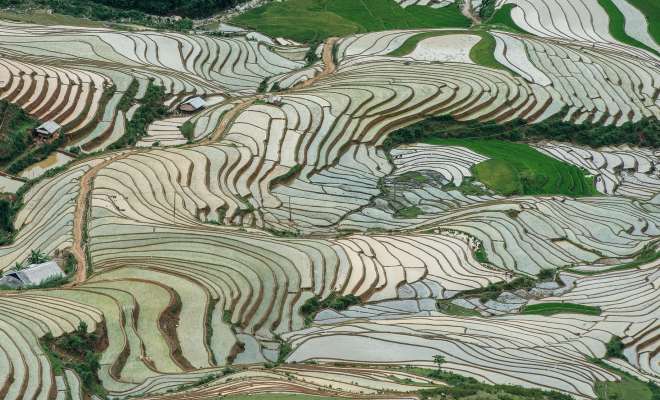
This is also the time that fields are plowed, either using water buffalo or small mechanical tillers made to fit the small rice plots and terraces.
The earth feels raw and landscapes at this time have an elemental beauty.
The great benefits of traveling in the northern winter are the low number of other tourists, respite from the heat of summer, and low rainfall — December and January are the driest months in the North. Hanoi is still busy but (outside the Western Xmas holiday period and the New Year festival of Tet) has fewer tourists and the major sites can feel relatively uncrowded.
With fewer travelers, the mountains and valleys feel even more remote and unspoiled.
As winter ends, there tends to be a very quick shift from cool weather through a brief spring that lasts just a few weeks to hot and humid: April and especially May can be the hottest months of the year in the North.
Days are hot because the overcast skies of winter have largely gone and the sun is often shining — which sends the temperature and humidity up, but is great for views!

As early spring arrives, flowers appear and new rice is planted in lowland paddies and rice terraces (where there are two rice harvests per year, the first new planting is in early spring; at higher altitudes where there is only one harvest, the new planting occurs later).
Combined with the sunnier weather this can make for beautiful landscapes. In the mountains in particular, slightly cooler temperatures, spring flowers and the bright green of new rice plantings can make April / May a spectacular time to travel, provided you can handle the heat while traveling through the lowlands. There are fewer crowds too.
In Hanoi, in May and June, lotus flowers are at their peak, and the lotus ponds around Tay Ho are full of stunning pink blooms on slender stalks, cut for the markets early each morning by the lotus boat men and women.

Some relief from May and June’s heat and humidity is close by with (slightly) more reasonable temperatures from late June to August. It can still be very hot and humid when it’s sunny, especially in the lowlands, but June can also be a great time to travel.
In lowlands and moderate altitudes, where there are two rice harvests each year, the first half of June is when the first rice harvest often takes place.
In the weeks before the lowland harvest, in late May and early June, depending on the year, the ripe rice turns golden yellow and it can be one of the most beautiful times to travel. It’s still relatively uncrowded too.
During harvest time, villagers work together in a communal effort to cut and thresh the rice — often cutting by hand with a scythe and threshing either manually or using a small mechanical thresher about the size of a lawnmower that is wheeled out among the fields. It’s an amazing spectacle.

Late May and all through June is also a good time to visit the tea plantations that are found, among other places, in the ranges west of the Red River delta, near towns such as Moc Chau.
In spring and early summer, the tea leaves are budding and leaves are picked nearly every day — women pick by hand, filling the baskets on their backs.

Summer, and especially during July and August, is the wettest part of the year. The rain often comes as afternoon or evening thunderstorms, which can last from a few minutes to a few hours.
Both in Hanoi and the countryside it is possible to enjoy a sunny day of travel and discovery, taking shelter from the thunderstorms when necessary.
But summer rain can also last for days, and during the typhoon season from July to November when a typhoon hits there can be widespread flooding and storm damage.
North Vietnam is less affected by typhoons than Central and Southern Vietnam, but getting the best out of traveling in July and August can require flexibility and patience, as well as good wet weather gear! The rewards can be great — the countryside is incredibly green and bountiful; waterfalls are at their best; and everything seems fresh and full of life.
By September and October the rains are generally tapering off, notwithstanding any typhoons, and there are more sunny days.
By late September there are often blue skies, milder temperatures and the highlands rice is turning golden getting ready to be harvested.
This can be the best time to travel in North Vietnam. The rice terraces are magnificent, trekking can be splendid with warm days and cool evenings, summer fruits are still in abundance, the harvest spectacle is taking place, motorcycle riding is wonderful.
In Hanoi by late October there can be beautiful blue-sky days with gentle breezes and early morning fog on the lakes. Hanoi and parts of the North even get a short season of fall color, perhaps best seen around the Hanoi lakes and in the countryside beyond Hanoi.
Weather & seasons in Central Vietnam – detail

Central Vietnam is the long, thin part of Vietnam that stretches from about Than Hoa in the North to where the highlands south of Dalat meet the Mekong delta. It includes Hoi An, Da Nang, Hue, Dalat, as well as lesser known places like Phong Nha and Dong Hoi.
Central Vietnam is kind of a transition area climate-wise from the North to the South. Its weather is very much affected by the Truong Son mountain range, which runs down the central spine of Vietnam and includes the central highlands areas of Dalat and Pleiku.
These mountains shelter the central coast from much of the rains that normally come with the southwest monsoon, although the impact varies as one moves further north away from the Mekong, and also as one moves away from the coast into the mountains.
The result is that weather, temperatures and rainfall tend to vary more from place to place in central Vietnam than in either the North or South.
Hoi An and Da Nang
Travel in the central coastal areas of Hoi An and Da Nang is best from about late January / early February to July / August, during the dry season. Although the coastal area does get some rain during this time, it is considerably drier than other parts of the country.

Hoi An can be wet in May, and both Hoi An and Da Nang can be very wet in September / October / November, when it can rain for extended periods. October to November is also typhoon season, and while the central coast is not affected by a typhoon every year, when it is, there can be severe weather and flooding along the whole central coast.
Even when there is no typhoon, heavy rains sometimes combined with large tides mean that Hoi An is particularly prone to flooding in October / November — not the best time to visit Hoi An’s renowned beaches or wander among its historic old houses.

December and January can get quite cool in Da Nang, which has quite a large temperature variation between winter and summer, while Hoi An has less difference — traveling in Hoi An in winter is significantly milder than Da Nang.
Peak visitor times for Hoi An seem to be around Xmas and then the summer months, so traveling around late March / April / (early) May can be a great time — fewer crowds, mostly good weather, hot enough for the beaches, which by late April / May will have some cheaper prices and more ability to bargain, good snorkeling (though June is better), and Cham Island will have tourist boats making the journey.
More or less the same applies to Da Nang.

Hue
Hue’s weather is somewhat different, and is known to be notoriously drizzly for the greater part of the year due to its unique location within the Truong Son mountain range, which seems to bottle up all the moisture.
Things get even wetter than usual in the late autumn / winter rainy season, especially from October to December / January and sometimes even into February. To be safe, bring along an umbrella at any time of year.
Don’t forget to bring a sweater and jacket in winter as it can get rather chilly, with temperatures falling to as low as 8 degrees at night. Alternatively, when the sun makes an appearance, it can quickly get hot.
It is usually relatively dry during the summer months, when the temperature can reach the high 30’s. Summer rains can be heavy but brief, and often arrive unexpectedly, whereas winter rains can last for weeks.

Hue’s Royal Palace above the forbidden city moat
The best description for the weather in Hue would be “changeable”: the most enjoyable time to visit the Hue area is in the spring, from March to May.
This is when both Hue and the temples along the Perfume River are likely to be at their best. In March, temperatures are not yet summer-hot and this is a good time for walking around the UNESCO World Heritage sites of Hue Imperial City and the temples scattered along the banks of the Perfume River.
Although a little warmer, April / May is a good time for exploring the nearby countryside, when rice fields are a brilliant green and spring flowers are out.
Phong Nha
North of Hue, we think the Phong Nha caves in the Phong Nha Ke Bang National Park are a must-see if you are traveling in this area. They are inland from the coast, in the north-central ranges which rise to about 800m.
Though not much visited even a few years ago, the discovery of the Son Doong cave, the largest in the world, has raised the profile of the area and it can be crowded in peak season — as much by local tourists as by international visitors. Access to Son Doong itself is expensive and restricted, but there are many other caves nearby with vast caverns and magnificent formations that are easily accessible.
In addition, parts of the Ho Chi Minh Trail are nearby, some of them passing through remote and beautiful rain forest; with relatively little traffic, these make for splendid motorbike riding.

While many of the caves do not require getting wet, one of the unique experiences here is to be able to swim in the rivers that run through some of the caves. This is only possible in the drier months (roughly December to August), as the water level is too high during wet season (‘flooding season’ is generally around mid-September to mid-November) and there is too much sediment.
The water in the caves is cold all year round, and the insides of the caves are at a fairly constant temperature — but we think exploring those caves which require getting wet is still probably better done in relatively warm weather.
From the perspective of both exploring the caves and motorbike riding, March – May is perhaps the best time, though February – August is also OK if cave swimming is not on the menu.

The central highlands are the southern part of the Truong Son mountain range, stretching from inland of Quang Ngai to just north of the Mekong basin, and including Da Lat and Pleiku.
While receiving, on average, a greater amount of rainfall than the rest of the country, the highlands maintain an appealingly cooler climate year-round, offering a welcome respite from the heat at any time.
Da Lat is cool in winter (December & January), with January average maximums in the low 20s and minimums around 15º C. March is the warmest month with minimums in the low 20s and maximums around 30º C. There is a dry season from November to March and a wet season from around late April to October.
There tends to be more sun January – March (although there can be sun and dry days in most months of the year) and then increasing cloud cover as the wet season arrives. June and July bring thunderstorms, but this can be a good time to travel if the storms are relatively short and days are otherwise fine, even if cloudy.
In addition, Da Lat is famously foggy or covered in low cloud a lot of the year. Much of this weather is driven by Da Lat’s position on a plateau at around 1500m; drop off the plateau to lower altitudes and the weather can be quite different — warmer and drier.
Da Lat is famous for its flowers grown year-round, but perhaps best seen during the dry season. The Da Lat Flower Festival is held every other year in December and this marks peak flower season.
Weather & seasons in South Vietnam – detail

The cities and towns of southern Vietnam, covering basically the Mekong valley and delta, and including Ho Chi Minh (still called Saigon by many South Vietnamese) and the island of Phu Quoc, vary considerably weather-wise but the climate here is more temperate than northern and central Vietnam.
Daytime temperatures in the region rarely drop below 20°C, and occasionally hit 40°C during the hottest months of March, April and May, but temperatures of about 25°C – 35°C, are normal year-round. Hats and cool loose clothing are essential.
Southern Vietnam’s dry season lasts from November / December to late April or May, depending on the year. During the southwest monsoon from late April / May to October / November there tends to be plenty of rain and hot, humid weather with June to August being especially wet.
Typhoon season peaks in October / November.
The levels of humidity vary a lot throughout the year, with peak humidity being between February and May.

Brief afternoon downpours (refreshing!) are the norm during the rainy season, and while this may not cause too much interruption to your plans, it often does cause flooding in Ho Chi Minh city and the Mekong Delta, as well as on Phu Quoc island, which often experiences poor weather and rough seas at this time.
The monsoonal rains can make transport more complicated, sometimes causing roads to be washed out or more remote villages to be temporarily cut off.
Ho Chi Minh and the Mekong Delta are best weather-wise from November through to February or March. April to August can also be good as long as you travel prepared for (mostly short lived) thunderstorms.
In particular, May / June before and then during the rice harvest can also be a great time to travel as long as you can handle the heat — the rice paddies are beautiful, and the harvest itself is always a spectacle worth seeing. Phu Quoc has broadly similar weather but a longer dry season and is best from November through to May.
As always, just contact us if you want more information.
Festivals & events

Expressing reverence, maintaining ancient traditions, remembering dead heroes, commemorating important events, demonstrating sporting abilities, or simply entertaining the community, Vietnamese culture has a long tradition of colorful festivals.
Most festivals take place according to the lunar calendar, which is also closely linked to the Chinese system with a zodiac of twelve animal signs. The most important times during the lunar month (which lasts 29 or 30 days) are the days of the full moon (day one) and of the new moon (day fourteen or fifteen), and festivals often take place on these days.
Apart from the national events, many local festivals take place throughout the year around the country.
These can feature puppet shows, folk songs, traditional music, local dances, wrestling, rowing, rice cooking, rope pulling, rope climbing, chess playing, cockfights, buffalo fights, and pigeon races. There are also scores of regional festivals, often jointly celebrated by collections of villages and ethnic groups.

Festivals, seasons and religion are intertwined. Most festivals take place in the spring, with a second wave in autumn — plus of course at lunar New Year, known universally as Tet, which generally takes place sometime in January or February and is the largest and most important national festival in the country.
Religion is woven into most festivals, just as it is into the everyday lives of most Vietnamese.
Most people practice a Vietnamese combination of Confucianism and Taoism, both of which came originally from China. Buddhism, which came from India via the Khmer civilization of ancient Cambodia and southern Vietnam, also has a significant influence.
Ancestors are venerated and most houses have a shrine to their ancestors, where prayers are offered frequently; ancestors are considered to have a crucial role in current lives and family fortunes.
Buddhist temples and shrines are scattered throughout Vietnam, some of them dating back a thousand years or more, and in addition to the household shrine it is common to offer prayers and incense at them as part of the rhythm of weekly and monthly life.
Most festivals celebrate a seasonal event, like New Year or the arrival of Spring or the harvest, or remembering and revering the ancestors or spirit of the local village or temple or region.
As part of nearly all festivals, prayers and gifts will be offered to ancestral spirits in the hope that they will banish bad luck and bring good fortune to individuals, families and communities.
During major festivals, important temples are packed with locals and pilgrims — take note if you are uncomfortable with large crowds.
The most common non-festival events you are likely to come across are weddings and funerals, both among the most important occasions in Vietnamese family life.
The most propitious time for weddings is the 10th lunar month, and you are likely to see temporary marquee wedding reception tents hosting a joyous party with colorful flowers and decorations and loud music almost anywhere, from streets and lane-ways in cities to fields in tiny villages.
Wealthier weddings tend to be in private houses, so it is mostly humble weddings that you will see — if you are walking or riding past, you are likely to be offered a drink and a welcome: it’s a genuine offer, so accept if you want and you are likely to have a wonderful, memorable time.
Funerals depend on the importance of the deceased, and can involve large processions of mourners and musicians for higher status people.
Like weddings, funerals also have a gathering in a marquee tent with colorful flowers and decorations and often loud dirge-like music — mourners wear a white gauze head band, so it’s easy to distinguish a funeral from a wedding.

In between the major festivals, there are many smaller local and ethnic minority festivals throughout Vietnam.
The Red River basin, the large delta of which Hanoi is the major city, in particular has many village festivals that are relatively easy to access.
Experiencing a festival is a great thing to do as part of a trip to Vietnam — they are windows into a vibrant and fascinating culture.
We have outlined below some of the better-known festivals, but dates change from year to year depending on the alignment of the lunar and Western calendars — contact us for more details!
January — March
Tet
Undoubtedly Vietnam’s most important annual event and most widely celebrated festival is Tet, or New Year, properly known as Tet Nguyen Dan, or ‘The Feast of the First Morning of the First Day’.
Tet lasts for around a week and falls sometime between the last week of January and the third week of February, on the night of the new moon.

The few weeks prior to Tet are the most hectic of the year, as people purchase items for the Tet festival and travel back to their villages of origin to be with their extended families.
In this pre-Tet madness there is an energetic buzz on the streets as people are out looking for, and then transporting, the best kumquat and peach blossom tree they can afford to their homes (these bring prosperity and good luck).
The streets become a sea of orange and pink as motorbike riders are pushed to the edges of their seats, and trucks are filled to capacity in order to accommodate their valuable loads.
The Lunar New Year migration is one of the largest movements of people on the planet — and there can mind bending traffic jams on key roads in the Vietnamese countryside as millions head back to their family village. Plan carefully!
Everyone is in a rush to get a haircut, buy new clothes, spruce up their homes, visit friends, settle outstanding debts, and stock up on traditional Tet delicacies. Businesses hang festive red banners which read “Chuc Mung Nam Moi” (Happy New Year) and city streets are festooned with colored lights.
The actual first few days of the Tet festival are much less chaotic and the streets are eerily quiet as everyone has already gotten to where they need to be, with their families.
This is a time when families get together to celebrate renewal and hope for the new year, when ancestral spirits are welcomed back to the household, and also when everyone in Vietnam becomes a year older – age is reckoned more by the new year than by individual birthdays.

Tet Festival is a great time for locals and even visitors to enjoy an array of traditional Vietnamese dishes such as banh chung (steamed square cake), gio cha (Vietnamese ham/sausage), xoi (sticky rice), and thit ga (steamed chicken).
Visitors are invited to have tea and mut (various dried fruits and seeds), which is kept in ornate boxes and placed on the table in the living room. Children are usually given “lucky money” in red envelopes by their parents and elder relatives. The streets are filled with people performing mua lan or lion dances with drums, bells, gongs, and firecrackers going off to ward off evil spirits (even though firecrackers are officially banned).
As it is the most important festival in Vietnam, most offices, shops, restaurants, and attractions are closed for the first three days of Tet, which can make it slightly inconvenient for visitors. Flights are also often fully booked about a week before the festival, so it’s highly recommended that you plan well in advance and book your flights to and within Vietnam as early as possible.
Upcoming dates in the Western calendar for Tet:
- 2022 – from January 31 (New Year’s Eve) to February 4
- 2023 — from February 21 (New Year’s Eve) to January 27
- 2024 – from February 9 (New Year’s Eve) to February 15
Lim Festival
The Lim Festival is a special cultural activity for worshiping Ba Mu (who legend has it lived the life of a Buddhist nun at Lim Pagoda and protected the villagers from a severe drought) as well as for celebrating the “Quan Ho” folk song, particularly well-loved in the Northern Red River Delta region.
Visitors come to Lim Village in Bac Ninh province, about 18 km from Hanoi, to watch performances of the traditional “Quan Ho” songs performed by some of the country’s most skilled “lien anh” (male singers) and “lien chi” (female singers). The Lim Festival also incorporates traditional games, one of which features a competition in which the Noi Due girls weave while singing Quan Ho songs.
The Lim Festival is held on the 13th day of the first lunar month, corresponding to the following upcoming dates in the Western calendar:
- 2022 – February 5
- 2023 — February 13
- 2024 — February 22
Perfume Pagoda Festival
The Perfume Pagoda, also known as Huong Pagoda, a vast complex of Buddhist temples and shrines built into the limestone Huong Tich mountains, is Vietnam’s most famous Buddhist pilgrimage site.
Hundreds of thousands of pilgrims from all over Vietnam flock to the sacred Perfume Pagoda early in the new year to pray for a happy and prosperous year ahead.

Boats, usually rowed by young women, carry worshipers along the Yen Vi river through a stunning landscape of blazing green rice paddies studded with jagged limestone mounts to the base of Huong Mountain.
From the riverbank, pilgrims proceed on foot, past various ancient pagodas, monasteries and shrines, up hundreds of stone steps and a switchback trail, all worn smooth by the passage of countless feet.
Because of its popularity, the Perfume Pagoda can be uncomfortably crowded for at least one month prior to and after the actual festival date, so if you’re not fond of queues, crowds and general chaos, it is probably best to visit this stunning site at a less congested time. If you can bear the crowds, it is a unique glimpse into the spiritual life of Vietnam.
The Perfume Pagoda Festival takes place on the 15th day of the first month of the lunar calendar, which corresponds to these dates in the Western calendar:
- 2022– February 15
- 2023 — February 5
- 2024 — February 24
March – May
Thay Pagoda Festival
This annual event pays homage to the Vietnamese monk, Tu Dao Hanh, who lived at the Chua Thay Pagoda, located about 20 km southwest of Hanoi in the shadows of the Sai Son Mountains.
Innovator and inventor, the monk is mainly remembered for inventing Vietnamese water puppetry, a now integral element of the must-see sights in Hanoi.
The festival is a homage to Tu Dao Hanh’s life, with worship and games and many water puppetry performances held at the Thuy Dinh House in front of Tu Dao Hanh’s pagoda.

The Thay Pagoda Festival takes place on the 5th to the 7th day of the third month of the lunar calendar, which correspond to these dates in the Western calendar:
- 2022 – April 5 — 7
- 2023 — April 24 — 26
- 2024 — April 13 — 15
Hung Festival
Every year, a large number of visitors from all over the country participate in the national Hung King Temple Festival — an incense-offering ceremony in honor of the Hung Kings, who were instrumental in the founding of the nation.
To commemorate the valiant sons of this lineage, festival-goers gather at the Hung Temple, located near Viet Tri city in Phu Tho province, about 80 kilometers from Hanoi, where they light incense, make offerings, and beat bronze drums before indulging in a variety of performances including traditional Vietnamese operas and sword dances.
This nationwide holiday is traditionally celebrated on the tenth day of the third lunar month, which corresponds to these dates in the Western calendar:
- 2022 – April 10
- 2023 — April 29
- 2022 — April 18

Liberation Day
Known as ‘Ngày Thống nhất’ in Vietnamese, it is also known as Victory Day or Reunification Day. Some Vietnamese may still call it ‘the day Saigon fell’.
It marks the fall of the Saigon government on April 30, 1975 when the Viet Cong and north Vietnamese troops captured Saigon (now Ho Chi Minh City).
This brought the Vietnam war to an end and began the process of unification of the Democratic Republic of Vietnam (North) in the North and the Republic of Vietnam (South).
Events are held over several days throughout the country though Hanoi sees some of the most interesting parades, performances, local festivals and firework displays.
Streets in big cities like Hanoi, Hue, Da Nang and Ho Chi Minh City are eye-catchingly decorated with colorful banners, flags and neon lights.
Because of this extended break, many people take the time to return to their families. Banks and government offices will close, but most shops remain open.
Tourist sites may be busier than usual, with the Ho Chi Minh Mausoleum in Hanoi being the top place to visit.
This holiday is celebrated on April 30. If it happens to fall on a weekend, a public holiday will be observed on the following weekday.

Giong Festival
This festival commemorates the national hero Saint Giong, one of the four immortals of Vietnam who defeated the An invaders from China.
Held annually in Phu Dong Village outside of Hanoi, a large and colorful procession moves from one temple to another culminating in a feast and opera performances.
This large festival is held on the 9th day of the 4th month of the lunar calendar, which corresponds to these dates in the Western calendar:
- 2022 — May 9
- 2023 — May 27
- 2024 — May 16
June – December
National Day
Observed on September 2nd to commemorate the Vietnam Declaration of Independence from France in 1945, this public holiday has parades in Ba Dinh Square in front of Hồ Chí Minh’s mausoleum in Hanoi, and fireworks displays and people’s rallies.
It’s a huge event, and Hanoians especially party it up by shutting off extra streets to allow only pedestrian traffic. Every five years, boat races are held on Hoan Kiem lake in honor of the more than 70-year-old historical event.
Those traveling in Vietnam on National Day should be aware that all government agencies and many businesses are closed.
The visa counters at international airports are still open, but other visa services are closed. It is best to apply for a visa well in advance and to reserve your ticket and hotel room well ahead of time as well.
Mid-Autumn Festival
Also known as the Full Moon Festival, or “Tet Trung Thu”, this is one of the Vietnam’s most entertaining festivals.
It is said that originally, the Mid-Autumn Festival was created to give a chance to the parents, who were busy during harvest season, to make up for lost time with their children and do something special with them, as well as celebrate the harvest. It was held under the full moon, which represents fullness and prosperity of life.
The Western equivalent of Tet Trung Thu would be a combination of Halloween and Thanksgiving.
Toting traditional (and not-so-traditional) colorful lanterns, children parade on the streets, dancing traditional dragon and flower dances.

Festive cakes
It is customary to give Banh Trung Thu, boxes of moon cakes, which are traditionally very rich in taste (but not to everyone’s taste!).
The beautiful decorative cakes are traditionally filled with lotus seeds, ground beans and orange peel and have a bright yolk in the center to represent the moon. However, the market is much more diverse these days, and the moon cakes have become much more diverse in flavor (and palatability).
It used to be the custom to light and release paper lanterns, which were believed to float away all problems and sadness, to give long life and to drive away bad omens and darkness for those who released them.
However, the government has put a stop to this mid-autumn festival practice as it proved to be quite dangerous, as the lanterns exhausted their supply of fuel (an ignited, petroleum-soaked cloth filled the lantern with gas to make it rise), and careened to ground, igniting roofs and other flammable objects on their descent.
Today, the Mid-Autumn Moon Festival, as well as encouraging affection for children, promotes education, poetry, dance and arts and crafts. It is a lively, fun festival for the whole family and visitors would be lucky to witness it first-hand.
This festival is held on the day of the full moon during the 8th lunar month, which corresponds to these dates in the Western calendar:
- 2022 – September 10
- 2023 — September 29
- 2024 — September 17
Christmas & New Year
While a small percentage of Vietnamese are Christians, the great majority of them residing primarily in the south, Christmas is not a big celebration here.
Over the years, there has been increasing commercialism related to Christmas, with decorated hotels and shopping centers and gift giving, especially among younger Vietnamese. Mostly though, outside the major towns the holiday goes largely unnoticed.
New Year’s Day, 1 January, has been celebrated in Vietnam since the period of French colonization when the Western calendar came into use.
Over time, the Western New Year has become widely accepted among the Vietnamese and has become a public holiday; however, tourist services are very much operational. New Year’s parties are commonplace. Ho Chi Minh city is a little flashier than Hanoi, with impressive fireworks displays bringing in the New Year.
Other Festivals
In addition to Vietnam’s better- known festivals, there are numerous other festivals, many of them specific to particular ethnic minorities, or regions or even villages, that are worth exploring if they can be fit into your travels.
They can be hard to find, with reliable information difficult to come by and dates that change each year, and sometimes they can be hard to access if they are in remote locations, but it’s worth trying — what you’ll find are traditions preserved intact, often without the self-consciousness that goes along with overexposure.
For more information on festivals in Vietnam, contact us – we’ll be happy to help.



